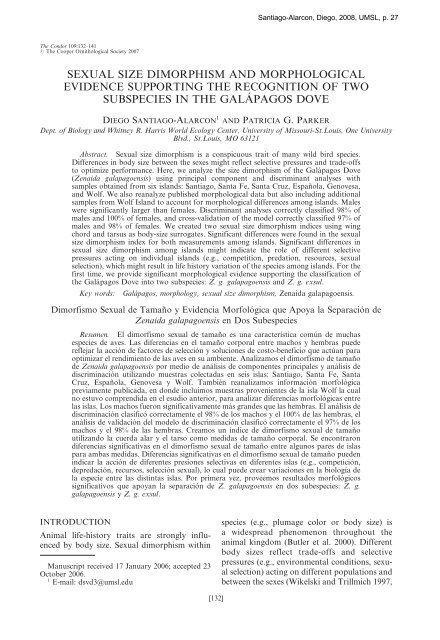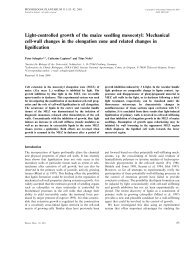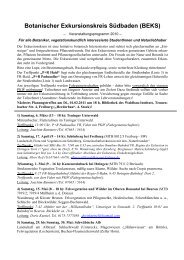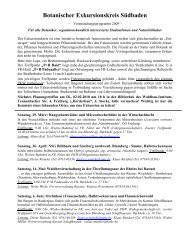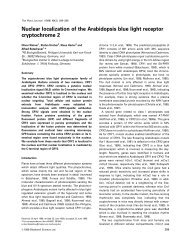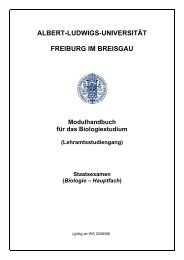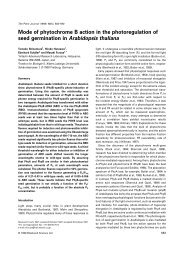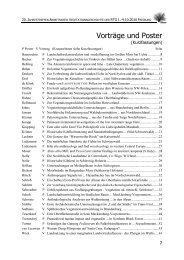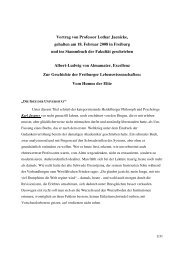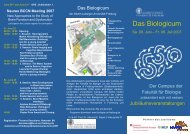SEXUAL SIZE DIMORPHISM AND MORPHOLOGICAL EVIDENCE ...
SEXUAL SIZE DIMORPHISM AND MORPHOLOGICAL EVIDENCE ...
SEXUAL SIZE DIMORPHISM AND MORPHOLOGICAL EVIDENCE ...
You also want an ePaper? Increase the reach of your titles
YUMPU automatically turns print PDFs into web optimized ePapers that Google loves.
The Condor 109:132–141<br />
# The Cooper Ornithological Society 2007<br />
<strong>SEXUAL</strong> <strong>SIZE</strong> <strong>DIMORPHISM</strong> <strong>AND</strong> <strong>MORPHOLOGICAL</strong><br />
<strong>EVIDENCE</strong> SUPPORTING THE RECOGNITION OF TWO<br />
SUBSPECIES IN THE GALÁPAGOS DOVE<br />
DIEGO SANTIAGO-ALARCON 1 <strong>AND</strong> PATRICIA G. PARKER<br />
Dept. of Biology and Whitney R. Harris World Ecology Center, University of Missouri-St.Louis, One University<br />
Blvd., St.Louis, MO 63121<br />
Abstract. Sexual size dimorphism is a conspicuous trait of many wild bird species.<br />
Differences in body size between the sexes might reflect selective pressures and trade-offs<br />
to optimize performance. Here, we analyze the size dimorphism of the Galápagos Dove<br />
(Zenaida galapagoensis) using principal component and discriminant analyses with<br />
samples obtained from six islands: Santiago, Santa Fe, Santa Cruz, Española, Genovesa,<br />
and Wolf. We also reanalyze published morphological data but also including additional<br />
samples from Wolf Island to account for morphological differences among islands. Males<br />
were significantly larger than females. Discriminant analyses correctly classified 98% of<br />
males and 100% of females, and cross-validation of the model correctly classified 97% of<br />
males and 98% of females. We created two sexual size dimorphism indices using wing<br />
chord and tarsus as body-size surrogates. Significant differences were found in the sexual<br />
size dimorphism index for both measurements among islands. Significant differences in<br />
sexual size dimorphism among islands might indicate the role of different selective<br />
pressures acting on individual islands (e.g., competition, predation, resources, sexual<br />
selection), which might result in life history variation of the species among islands. For the<br />
first time, we provide significant morphological evidence supporting the classification of<br />
the Galápagos Dove into two subspecies: Z. g. galapagoensis and Z. g. exsul.<br />
Key words: Galápagos, morphology, sexual size dimorphism, Zenaida galapagoensis.<br />
Dimorfismo Sexual de Tamaño y Evidencia Morfológica que Apoya la Separación de<br />
Zenaida galapagoensis en Dos Subespecies<br />
Resumen. El dimorfismo sexual de tamaño es una característica común de muchas<br />
especies de aves. Las diferencias en el tamaño corporal entre machos y hembras puede<br />
reflejar la acción de factores de selección y soluciones de costo-beneficio que actúan para<br />
optimizar el rendimiento de las aves en su ambiente. Analizamos el dimorfismo de tamaño<br />
de Zenaida galapagoensis por medio de análisis de componentes principales y análisis de<br />
discriminación utilizando muestras colectadas en seis islas: Santiago, Santa Fe, Santa<br />
Cruz, Española, Genovesa y Wolf. También reanalizamos información morfológica<br />
previamente publicada, en donde incluimos muestras provenientes de la isla Wolf la cual<br />
no estuvo comprendida en el esudio anterior, para analizar diferencias morfológicas entre<br />
las islas. Los machos fueron significativamente más grandes que las hembras. El análisis de<br />
discriminación clasificó correctamente el 98% de los machos y el 100% de las hembras, el<br />
análisis de validación del modelo de discriminación clasificó correctamente el 97% de los<br />
machos y el 98% de las hembras. Creamos un índice de dimorfismo sexual de tamaño<br />
utilizando la cuerda alar y el tarso como medidas de tamaño corporal. Se encontraron<br />
diferencias significativas en el dimorfismo sexual de tamaño entre algunos pares de islas<br />
para ambas medidas. Diferencias significativas en el dimorfismo sexual de tamaño pueden<br />
indicar la acción de diferentes presiones selectivas en diferentes islas (e.g., competición,<br />
depredación, recursos, selección sexual), lo cual puede crear variaciones en la biología de<br />
la especie entre las distintas islas. Por primera vez, proveemos resultados morfológicos<br />
significativos que apoyan la separación de Z. galapagoensis en dos subespecies: Z. g.<br />
galapagoensis y Z. g. exsul.<br />
INTRODUCTION<br />
Animal life-history traits are strongly influenced<br />
by body size. Sexual dimorphism within<br />
Manuscript received 17 January 2006; accepted 23<br />
October 2006.<br />
1 E-mail: dsvd3@umsl.edu<br />
[132]<br />
Santiago-Alarcon, Diego, 2008, UMSL, p. 27<br />
species (e.g., plumage color or body size) is<br />
a widespread phenomenon throughout the<br />
animal kingdom (Butler et al. 2000). Different<br />
body sizes reflect trade-offs and selective<br />
pressures (e.g., environmental conditions, sexual<br />
selection) acting on different populations and<br />
between the sexes (Wikelski and Trillmich 1997,
Owens and Hartley 1998). In general, there is<br />
a strong positive association between sexual size<br />
dimorphism and individual body size (Fairbairn<br />
1997, Wikelski and Trillmich 1997).<br />
Apparently, this relationship results from the<br />
advantage of being large, with the sexes<br />
benefiting in different ways as size increases.<br />
Males may acquire priority access to food<br />
resources, better territories, and increased<br />
mating success; females may acquire higher<br />
fertility (Fairbairn 1997, Wikelski and Trillmich<br />
1997).<br />
Geographic isolation of populations is expected<br />
to influence differentiation of both<br />
morphological and genetic characters, due to<br />
drift or different selective regimes (Slatkin 1985,<br />
Hutchison and Templeton 1999, Coleman and<br />
Abbott 2003). Santiago-Alarcon et al. (2006)<br />
showed that males and females of the Galápagos<br />
Dove (Zenaida galapagoensis) are morphologically<br />
similar among five islands of the<br />
Galápagos archipelago (Santa Fe, Santa Cruz,<br />
Santiago, Española, and Genovesa). High gene<br />
flow is apparent among these islands (Santiago-<br />
Alarcon et al. 2006); hence, significant differences<br />
in sexual size dimorphism among islands<br />
would not be expected. However, as Wikelski<br />
and Trillmich (1997) showed in lava lizards of<br />
the archipelago, sexual size dimorphism may<br />
vary significantly among populations located<br />
within the same island group and in close<br />
geographical proximity, possibly due to high<br />
variation in microclimatic conditions on different<br />
islands (Wikelski and Trillmich 1997).<br />
The Galápagos Dove is an endemic species<br />
whose biology is poorly known. Our knowledge<br />
about this species is restricted to taxonomic<br />
relationships (Goodwin 1977, Johnson and<br />
Clayton 2000), morphological records (Ridgway<br />
1897, Gifford 1913, Prestwich 1959), and<br />
some aspects of its breeding and feeding<br />
ecology on Genovesa Island (Grant and Grant<br />
1979). Morphological and ecological studies of<br />
birds in the Galápagos archipelago have been<br />
confined to few species, including Darwin’s<br />
finches (Bowman 1961, Boag 1981, 1983, Grant<br />
et al. 1985, Grant 2001), Galápagos mockingbirds<br />
(Nesomimus spp.; Curry 1988, 1989,<br />
Curry and Grant 1989), and the Galápagos<br />
Hawk (Buteo galapagoensis; Bollmer et al. 2003,<br />
2005). Measurements and general descriptions<br />
of Galápagos Doves are given by Ridgway<br />
(1897), Gifford (1913), and Swarth (1931).<br />
These authors provide measurements for a limited<br />
number of individuals and do not present<br />
any rigorous statistical analysis in support of<br />
their claims for two different subspecies of the<br />
dove. Color patterns in this species are the same<br />
for both sexes, although females tend to be<br />
duller than males. However, differences in color<br />
intensity are not obvious and can vary individually,<br />
making sex difficult to determine.<br />
Juveniles have a different color pattern than<br />
adults and are easily distinguished. Some<br />
aspects of the biology of sexually monochromatic<br />
bird species (i.e., the same or very similar<br />
plumage coloration between the sexes) are<br />
difficult to study in the wild because sexes are<br />
identical (Winker et al. 1996).<br />
We analyzed the sexual size dimorphism of<br />
the Galápagos Dove using principal component<br />
and discriminant analyses, created two sexual<br />
size dimorphism indices, and evaluated whether<br />
there were significant differences across islands<br />
by reanalyzing the morphological data in<br />
Santiago-Alarcon et al. (2006) but including<br />
samples from Wolf Island, individuals from<br />
which represent what is considered a different<br />
subspecies of the Galápagos Dove (Swarth<br />
1931, Grant and Grant 1979). The specific<br />
questions addressed in this study are:<br />
(1) whether there is sexual dimorphism in<br />
body size of the endemic Galápagos Dove;<br />
(2) whether there are differences among island<br />
populations in the degree of sexual dimorphism;<br />
and (3) whether there are morphological<br />
differences that separate the two subspecies.<br />
METHODS<br />
Santiago-Alarcon, Diego, 2008, UMSL, p. 28<br />
<strong>SIZE</strong> <strong>DIMORPHISM</strong> IN THE GALÁPAGOS DOVE 133<br />
FIELD METHODS<br />
We conducted this study in the Galápagos<br />
archipelago from May through July 2002, from<br />
June through July 2004, and during July 2005.<br />
We sampled individuals using hand nets and<br />
mist nets following the guidelines in Ralph et al.<br />
(1996). We took blood samples (50 ml) by<br />
venipuncture from 25 birds each from Santa<br />
Cruz (15 males, 10 females), Santa Fe (15<br />
males, 10 females), and Española Islands (11<br />
males, 14 females), 30 each from Santiago (18<br />
males, 12 females) and Genovesa Islands (20<br />
males, 10 females), and 29 from Wolf Island (13<br />
males, 16 females; Fig. 1). Samples were mixed<br />
with 500–700 ml of Longmire’s lysis buffer<br />
(Longmire et al. 1988). We used a PCR-based
134 DIEGO SANTIAGO-ALARCON <strong>AND</strong> PATRICIA G. PARKER<br />
technique for sexing individuals (Fridolfsson<br />
and Ellegren 1999). We visited San Cristobal<br />
during 2002 and Darwin during 2005, but due<br />
to small sample sizes (n 5 2 and 4, respectively)<br />
these islands were not included in our analysis.<br />
To quantify intersexual differences in morphology,<br />
we took the following measurements to the<br />
nearest 0.1 mm from the right side of each<br />
individual: (1) tarsus (from the joint between<br />
the tibiotarsus and the tarsometatarsus to the<br />
bent joint between the tarsometatarsus and<br />
metatarsals); (2) tail (posterior base of uropygial<br />
gland to tip of central rectrices); (3) exposed<br />
culmen (from the tip of the feathering to the<br />
bill’s tip); (4) bill width (calipers were oriented<br />
at a 90u angle to the axis of the bill and measurement<br />
was taken at the tip of the feathering);<br />
(5) bill depth (at the tip of the feathering and at<br />
90u angle to the axis of the bill); and (6) wing<br />
chord, to the nearest 0.5 mm, using a ruler with<br />
a brass perpendicular stop (unflattened, from<br />
carpal joint to the tip of the longest primary).<br />
Mass was measured to the nearest 0.1 g using<br />
Pesola scales (100 g and 300 g). Raw morphological<br />
measurements can be obtained by request<br />
from DS-A. Measurements were taken by<br />
DS-A on all the islands but Santa Fe, where<br />
Santiago-Alarcon, Diego, 2008, UMSL, p. 29<br />
FIGURE 1. Map of the Galápagos archipelago, with islands on which Galápagos Doves were measured<br />
shaded in gray. Wolf and Darwin islands are located 186 km and 239 km, respectively, northwest of the<br />
northern tip of Isabela Island.<br />
Jennifer Bollmer (JB) conducted the sampling.<br />
Although JB worked with DS-A on other<br />
islands and was instructed in dove measurement<br />
by DS-A, measurement error due to observer<br />
variability could create false differences among<br />
islands. Hence, both DS-A and JB measured<br />
Rock Pigeon (Columba livia) and Mourning<br />
Dove (Zenaida macroura) individuals at the<br />
Saint Louis Zoo to assess observer variability.<br />
There were no significant differences between<br />
these observers in any of the measured variables<br />
(same variables as measured in this study; Z $<br />
0.3, P $ 0.44). Wild birds were released within<br />
40 m of their capture location.<br />
STATISTICAL ANALYSES<br />
We used principal component analysis (PCA)<br />
to describe morphological variation between<br />
the sexes. We used SPSS v. 11.0.1 for Windows<br />
(SPSS 2001) in all analyses. Although all<br />
variables were normally distributed (Kolmogorov-Smirnov<br />
test, P $ 0.09) and had the<br />
same scale and dimension (except mass), they<br />
were log-transformed to examine the proportional<br />
contributions of large and small measurements<br />
equally. Principal component (PC)<br />
scores were normally distributed (Kolmogorov-
Smirnov test, P $ 0.86). All components with<br />
eigenvalues $1 were retained for subsequent<br />
analyses. Eigenvectors were rotated using varimax<br />
rotation. We retained rotated eigenvectors<br />
when the explained variance was higher than<br />
that of unrotated components or when the<br />
interpretation of principal components was<br />
easier. We used t-tests for group comparisons<br />
of PC scores (males vs. females); t-tests were<br />
independent and two-tailed. Variances of PC<br />
scores were homogeneous among groups (Levene’s<br />
test, P . 0.32). In addition to the<br />
dimorphism analysis, we conducted two PCAs,<br />
one for males and one for females, to examine<br />
morphological variation among islands. These<br />
analyses used previously published data (Santiago-Alarcon<br />
et al. 2006) with the addition of<br />
samples from Wolf Island, which were not<br />
available for analysis in the previous study.<br />
Individuals from Wolf Island represent what is<br />
considered a different subspecies of the Galápagos<br />
Dove (Z. g. exsul), which is restricted to<br />
the northern islands of Darwin and Wolf. We<br />
conducted the analyses describing morphological<br />
variation among islands separately by sex<br />
to prevent any variance due to sexual dimorphism<br />
from masking variation among populations.<br />
Bill depth was excluded from the PCA for<br />
females because only one individual was measured<br />
for this variable on one of the islands<br />
(Santiago). We used ANOVAs to test for differences<br />
among islands. We used Tukey post-hoc<br />
tests any time an ANOVA was significant.<br />
We used discriminant analysis (DA) to create<br />
a discriminant function that complemented the<br />
PCA analysis for sexual dimorphism. Because<br />
doves from Wolf Island are significantly larger<br />
(see results) than those of the southern islands,<br />
we conducted separate discriminant analyses<br />
for the southern subspecies (Z. g. galapagoensis)<br />
and the northern subspecies (Z. g. exsul).<br />
Samples from Genovesa Island were taken<br />
two years (2004) after the rest of the samples<br />
(2002), thus we decided to compute two discriminant<br />
analyses for the southern subspecies.<br />
One analysis excluded Genovesa samples,<br />
which subsequently were used to validate the<br />
model; the other analysis used all individuals<br />
from the five sampled islands. This second<br />
model was validated using the U-method (leaveone-out;<br />
McGarigal et al. 2000). In addition to<br />
the normality and variance assumptions fulfilled<br />
for PCA and detection of outliers, we<br />
Santiago-Alarcon, Diego, 2008, UMSL, p. 30<br />
<strong>SIZE</strong> <strong>DIMORPHISM</strong> IN THE GALÁPAGOS DOVE 135<br />
checked for equality of variance-covariance<br />
matrices using Box’s test for the two DA<br />
analyses (M 5 5.5, df 5 6, P 5 0.51 and M<br />
5 7.1, df 5 6, P 5 0.33, respectively). Multicollinearity<br />
was checked by conducting pairwise<br />
correlations (culmen vs. tarsus: r 5 0.82, P 5<br />
0.01; culmen vs. wing chord: r 5 0.77, P 5 0.01;<br />
and wing chord vs. tarsus: r 5 0.82, P 5 0.01;<br />
only correlations $0.7 are shown). We retained<br />
wing chord and tarsus and excluded culmen<br />
from the analysis because wing chord and<br />
tarsus explained most of the variance between<br />
groups (F 1,5 5 304.8, P , 0.001, and F 1,5 5<br />
448.2, P , 0.001, respectively). Even though<br />
tarsus and wing chord were highly correlated,<br />
they presented high tolerance during the variable<br />
selection process. In addition, we checked<br />
for agreement between standardized canonical<br />
coefficients and structure coefficients; variable<br />
weights were in the same rank order and had<br />
equal signs, thus proving the adequacy of the<br />
generated models. Prior probabilities were<br />
assumed to be equal because our sample<br />
included similar numbers of males and females,<br />
both when the discriminant analysis model<br />
included all samples and when Genovesa<br />
individuals were excluded. We conducted stepwise<br />
backward discriminant function analysis<br />
using Wilk’s lambda as the optimization<br />
criterion.<br />
We validated the discriminant analysis from<br />
Wolf Island using the U-method (leave-oneout)<br />
and we also used the four individuals (two<br />
males and two females) from Darwin Island,<br />
although we recognize the need for a much<br />
larger and independent data set to validate this<br />
model. We checked for equality of variancecovariance<br />
matrices using Box’s test (M 5 0.8,<br />
df 5 1, P 5 0.35). Multicollinearity was<br />
checked by conducting pairwise correlations<br />
(only mass vs. tail had a correlation .0.7 and<br />
both variables were excluded from the anlysis).<br />
Prior probabilities were assumed to be equal<br />
because our sample included a similar number<br />
of males and females.<br />
We calculated a sexual size dimorphism index<br />
(Smith 1999) as:<br />
ðmale size=female sizeÞ<br />
{ 1:<br />
Wing chord and tarsus were used as surrogates<br />
for body size to test whether there were<br />
significant differences in degree of sexual size
136 DIEGO SANTIAGO-ALARCON <strong>AND</strong> PATRICIA G. PARKER<br />
TABLE 1. Principal component (PC) scores and<br />
proportion of variance extracted (communalities)<br />
from each variable for the analysis of morphological<br />
differences between male and female Galápagos<br />
Doves. PC scores represent the correlation of each<br />
variable with the principal component and<br />
communalities are the sums of squares of the<br />
correlation coefficients on the first two components<br />
or the proportion of variance extracted from each<br />
variable.<br />
Variable PC1 PC2 Communalities<br />
Culmen 0.88 0.19 0.81<br />
Bill width 0.75 0.48 0.79<br />
Tarsus 0.89 0.18 0.84<br />
Tail 0.82 20.44 0.87<br />
Wing chord 0.93 20.02 0.87<br />
Mass 0.85 20.37 0.86<br />
dimorphism among islands. Wing chord and<br />
tarsus proved to be the two variables that best<br />
predicted body size according to the principal<br />
component analysis (high PC score and high<br />
extracted variance). Additionally, they were the<br />
variables that most reduced Wilk’s lambda<br />
during discriminant analyses (DA). To increase<br />
sample sizes among islands for the calculation<br />
of the sexual size dimorphism index we used the<br />
PopTools 2.5.4 (Hood 2003) add-in for Microsoft<br />
Excel to generate 100 randomizations for<br />
each population before the index was calculated.<br />
We took all individual measurements made<br />
on males and females from each island and used<br />
them as source data to generate 100 randomized<br />
measurements for each sex. We next<br />
calculated the sexual size dimorphism index as<br />
shown by the above formula for each of the 100<br />
measurement pairs and finally calculated the<br />
average of the 100 pairs. Because variances<br />
were not homogeneous across populations, we<br />
conducted a Kruskal-Wallis test to evaluate<br />
differences among islands in the degree of<br />
sexual size dimorphism. Values are reported as<br />
means 6 SD.<br />
RESULTS<br />
We retained the first component from the PCA<br />
conducted to compare the sexes for statistical<br />
analysis. PC1 explained 73% of the variance<br />
whereas PC2 explained 11%. PC1 described<br />
overall body size and the variance extracted<br />
from each variable was .79% (Table 1). Males<br />
were significantly larger than females (PC1: t 155<br />
529.3, P , 0.001; Fig. 2).<br />
Santiago-Alarcon, Diego, 2008, UMSL, p. 31<br />
FIGURE 2. Morphological ordination space between<br />
males and females of the Galápagos Dove.<br />
PC1 is an axis of overall body size and PC2 is a vector<br />
of bill and tail size and mass. Males are larger than<br />
females, and birds of both sexes are larger on Wolf<br />
Island (northern subspecies) than on the other islands<br />
(southern subspecies).<br />
For statistical analysis of females, we also<br />
retained the first component of the PCA. PC1<br />
explained 66% of the variance and described<br />
overall body size. PC2 explained 14% of the<br />
variance and was a compound size component<br />
defined mainly by bill width, tail, and mass<br />
(Table 2). The variance extracted from each<br />
variable was .76% (Table 2). We found<br />
significant differences among islands (F 5,61 5<br />
20.4, P , 0.001). Genovesa Island females were<br />
significantly smaller than females on Santa<br />
Cruz and Santiago Islands (Tukey test, HSD<br />
5 0.9 and 1.1, respectively, P # 0.01 for both<br />
comparisons); however, there was overlap<br />
among individuals of these islands (Fig. 3A).<br />
Wolf Island females were significantly larger<br />
than females from the other islands, clearly<br />
forming a separate group in ordination space<br />
from the rest of the female doves (Tukey test,<br />
2.2 . HSD . 1.2, P , 0.001 for all<br />
comparisons; Fig. 3A).<br />
For males, we retained the first component<br />
from the PCA for statistical analysis. PC1<br />
explained 60% of the variance and PC2<br />
explained 12%. PC1 described overall body size<br />
and PC2 was a compound size component<br />
defined mainly by bill width, tail, and mass<br />
(Table 2). The variance extracted from each<br />
variable was .63% (Table 2). We found<br />
significant differences among islands (F 5,73 5<br />
9.4, P , 0.001). Males from Genovesa Island<br />
were significantly larger than doves on Santa Fe
TABLE 2. Principal component (PC) scores and communalities (proportion of variance extracted) from the<br />
analysis of morphological differences of male and female Galápagos Doves among six islands of the<br />
Galápagos archipelago. PC scores represent the correlation of each variable with the principal component and<br />
communalities represent the sums of squares of the correlation coefficients on the first two principal<br />
components or the proportion of variance extracted from each variable.<br />
Variable<br />
FIGURE 3. (A) Morphological ordination space<br />
between islands for adult female Galápagos Doves.<br />
PC1 is an axis of overall body size and PC2 is a vector<br />
reflecting bill size and tarsus length. (B) Morphological<br />
ordination space between islands for male<br />
Galápagos Doves. PC1 is an axis of overall body<br />
size and PC2 is a composite vector reflecting bill size<br />
and tarsus length. Note that the y axes of A and B<br />
have different scales. Birds from Wolf Island<br />
(northern subspecies, Z. g. galapagoensis) are significantly<br />
larger than birds on the southern islands<br />
(southern subspecies, Z. g. exsul). There is broad<br />
overlap among birds of the southern islands.<br />
Males Females<br />
Santiago-Alarcon, Diego, 2008, UMSL, p. 32<br />
<strong>SIZE</strong> <strong>DIMORPHISM</strong> IN THE GALÁPAGOS DOVE 137<br />
PC1 PC2 Communalities PC1 PC2 Communalities<br />
Culmen 0.79 0.07 0.64 0.84 20.26 0.78<br />
Bill width 0.59 0.67 0.81 0.74 20.45 0.76<br />
Bill depth 0.80 0.37 0.77 Not included Not included Not included<br />
Tarsus 0.79 20.04 0.63 0.84 20.26 0.78<br />
Tail 0.77 20.36 0.73 0.72 0.54 0.82<br />
Wing chord 0.85 20.21 0.77 0.89 0.02 0.79<br />
Mass 0.77 20.33 0.71 0.80 0.45 0.85<br />
Island (Tukey test, HSD 5 0.9, P 5 0.02);<br />
however, as in the case of females, there was<br />
overlap among individuals of these islands<br />
(Fig. 3B). Male doves on Wolf Island were<br />
significantly larger than males on the other<br />
islands (Tukey test, 1.9 . HSD . 1.1, P #<br />
0.006 for all comparisons; Fig. 3B). As in the<br />
case of females, Wolf males also formed<br />
a separate group in ordination space (Fig. 3B).<br />
The discriminant analysis that excluded<br />
Genovesa individuals retained wing chord<br />
(W), tarsus (T), and tail (Ta) as significant<br />
variables discriminating between males and<br />
females (l 5 0.17, x 2 3 5 105.9, P , 0.001).<br />
Tarsus had the highest discriminating power (l<br />
5 0.22), followed by wing chord (l 5 0.19), and<br />
tail (l 5 0.17). The discriminant function was:<br />
D ~{41:08 z T0:689 ð Þ<br />
z W0:123 ð Þ z Tað0:08Þ: Individuals that scored zero or positive values<br />
were classified as males and those that scored<br />
negative values were classed as females. Canonical<br />
correlation was high (r 5 0.90). The model<br />
correctly classified 94% of males and 100% of<br />
females (Fig. 4). Cross-validation by the Umethod<br />
yielded 94% correct classification for<br />
males and 100% for females. When discriminant<br />
scores for Genovesa individuals were<br />
computed with the above function, we obtained<br />
100% correct classification for both males and<br />
females.<br />
The discriminant model including all samples<br />
from the southern islands retained wing chord<br />
(W), tarsus (T), and bill width (BW) as significant<br />
variables discriminating between groups
138 DIEGO SANTIAGO-ALARCON <strong>AND</strong> PATRICIA G. PARKER<br />
FIGURE 4. Scatter plot showing the two variables with the highest discriminating power (tarsus length and<br />
wing chord) for both males and females of the Galápagos Dove by island. Ellipses indicate individuals from<br />
Wolf Island. Inset is the box-plot of discriminant (DA) scores for males and females for the model that<br />
included all samples of the southern subspecies (Z. g. galapagoensis) of the Galápagos Dove. Birds from Wolf<br />
Island are larger than birds on the southern islands for both males and females. This result is supported by the<br />
discriminant analyses, which suggests that tarsus length and wing chord measurements are enough to<br />
confidently separate males from females.<br />
(l5 0.15, x 2 3 5 161.4, P , 0.001). As in the<br />
former model, tarsus was the variable that best<br />
discriminated between groups (l 5 0.19),<br />
followed by wing chord (l 5 0.16), and bill<br />
width (l 5 0.15). The discriminant function<br />
was:<br />
D ~{45:24 z T0:826 ð Þ<br />
z W0:14 ð Þ z BWð0:722Þ: Individuals that scored zero or positive values<br />
were classified as males and those that scored<br />
negative values were categorized as females.<br />
Canonical correlation was high (r 5 0.92). The<br />
model correctly classified 98% of males and<br />
100% of females (Fig. 4). Cross-validation by<br />
the U-method yielded 97% correct classification<br />
for males and 98% for females.<br />
The discriminant analysis for individuals<br />
sampled on Wolf Island retained only tarsus<br />
(T) as a significant variable discriminating<br />
between males and females (l 5 0.14, x 2 1 5<br />
52.6, P , 0.001). The discriminant function<br />
was:<br />
D ~{141:27 z T94:77 ð Þ:<br />
Santiago-Alarcon, Diego, 2008, UMSL, p. 33<br />
Individuals with scores of zero or positive<br />
values were classified as males and those<br />
scoring negative values were classed as females.<br />
Canonical correlation was high (r 5 0.93). The<br />
model correctly classified 100% of males and<br />
100% of females. Cross-validation by the Umethod<br />
yielded 100% correct classification for<br />
males and females. When discriminant scores<br />
for Darwin individuals were computed with the<br />
above function, we obtained 100% correct<br />
classification for both males and females. After<br />
conducting a discriminant analysis that included<br />
the samples from all six islands, the correct<br />
classification of males and females by the model<br />
decreased to around 80%. This result was due<br />
to the inclusion of individuals from Wolf<br />
Island, which are significantly larger than<br />
individuals from other islands, as shown by<br />
the PCA.<br />
We found significant differences among<br />
island populations in the degree of sexual size<br />
dimorphism for both wing chord (Kruskal-<br />
Wallis test: x 2 45 37.8, P , 0.001) and tarsus<br />
(Kruskal-Wallis test: x 2 45 29.3, P , 0.001)<br />
indices. Differences for the wing chord index
were identified between Genovesa and all the<br />
other islands (Genovesa 5 0.116 6 0.036,<br />
Santiago 5 0.083 6 0.034, Santa Cruz 5<br />
0.095 6 0.030, Española 5 0.090 6 0.041,<br />
Santa Fe 5 0.098 6 0.042, Wolf 5 0.088 6<br />
0.053). In the case of the tarsus index,<br />
differences were found between Santiago and<br />
Wolf Islands, and between Santa Cruz vs. Santa<br />
Fe, Genovesa, and Wolf Islands (Genovesa 5<br />
0.120 6 0.028, Santiago 5 0.108 6 0.029, Santa<br />
Cruz 5 0.100 6 0.044, Española 5 0.115 6<br />
0.042, Santa Fe 5 0.120 6 0.060, Wolf 5 0.129<br />
6 0.040). We plotted sexual size dimorphism vs.<br />
body size for both males and females by island<br />
(Fig. 5) and found no positive correlations<br />
between the two measurements. The sample<br />
from Wolf Island, in particular, had low sexual<br />
size dimorphism relative to individual size.<br />
DISCUSSION<br />
Our finding of significant morphological differences<br />
between the sexes is in agreement with<br />
morphological records for other Zenaida species,<br />
in which males are generally larger than<br />
females (Baptista et al. 1997). The three<br />
discriminant models developed in this study<br />
supported the results obtained by the principal<br />
component analysis. Importantly, the efficiency<br />
of the discriminant model was reduced when<br />
samples from Wolf Island (northern subspecies)<br />
were included in the analysis, which supports<br />
observed morphological differences between<br />
FIGURE 5. Scatter plot showing the sexual size<br />
dimorphism (SSD) wing index against the average<br />
wing chord (body size surrogate) for both male and<br />
female Galápagos Doves. The lack of a positive<br />
relationship between SSD and body size might reflect<br />
differences in selection pressures for both males and<br />
females on the different islands.<br />
Santiago-Alarcon, Diego, 2008, UMSL, p. 34<br />
<strong>SIZE</strong> <strong>DIMORPHISM</strong> IN THE GALÁPAGOS DOVE 139<br />
individuals from Wolf and from the other<br />
islands.<br />
This is the first study to provide statistically<br />
significant morphological evidence that supports<br />
the separation of the Galápagos Dove<br />
into two subspecies, as has been previously<br />
suggested by other authors (Ridgway 1897,<br />
Gifford 1913, Swarth 1931). This result suggests<br />
that populations on Wolf and Darwin islands<br />
might be somewhat isolated from the other<br />
islands, which is supported by significant<br />
positive F ST values (based on five microsatellite<br />
loci; see Santiago-Alarcon et al. [2006] for an<br />
explanation of the molecular and genetic<br />
analyses used) and lower gene flow between<br />
northern and southern islands as estimated with<br />
program MIGRATE (DS-A and PGP, unpubl.<br />
data). In contrast, there is evidence of high gene<br />
flow among populations of the southern subspecies<br />
based on microsatellite markers (Santiago-Alarcon<br />
et al. 2006).<br />
The sexual size dimorphism wing chord index<br />
calculated for Genovesa doves was significantly<br />
higher than indices calculated for the other<br />
islands. Because of high gene flow among<br />
southern island populations of the Galápagos<br />
Dove (Santiago-Alarcon et. al. 2006), morphological<br />
differences between the sexes on this<br />
island might be the result of phenotypic<br />
plasticity in response to different local conditions<br />
(Wikelski and Trillmich 1997). Genovesa<br />
Island is unique in the Galápagos archipelago<br />
in that the top predator, the Galápagos Hawk,<br />
has been replaced by the Short-eared Owl (Asio<br />
flammeus galapagoensis). Thus, variation in<br />
predation regimes on Genovesa due to different<br />
hunting strategies and other life history traits of<br />
the Short-eared Owl compared to the Galápagos<br />
Hawk, coupled with abiotic conditions,<br />
might be generating different pressures on the<br />
dove population of Genovesa.<br />
In addition, we identified significant differences<br />
between some island pairs for the sexual<br />
size dimorphism tarsus index. It has been suggested<br />
that tarsus size depends on the foraging<br />
strategy of a species (Miles and Ricklefs 1984).<br />
If the two sexes of a species have different<br />
ecological roles, some of their morphological<br />
traits might vary. Thus, differences in this<br />
sexual size dimorphism index between some<br />
islands might be due to differences in habitat<br />
structure and ecological interactions. For example,<br />
inhabited islands such as Santa Cruz
140 DIEGO SANTIAGO-ALARCON <strong>AND</strong> PATRICIA G. PARKER<br />
have been altered and are composed of habitats<br />
not found on other uninhabited islands. These<br />
differences among islands might represent areas<br />
of strong selection pressure for endemic doves.<br />
Nonetheless, because of high gene flow among<br />
southern island populations, observed differences<br />
are more likely the result of phenotypic<br />
plasticity.<br />
The ecological causes of sexual size dimorphism<br />
in the Galápagos Dove are difficult to<br />
identify because there are limited data for this<br />
species (Grant and Grant 1979). However,<br />
morphological differences are likely not the<br />
result of a single factor, but rather the result of<br />
multiple interacting factors (Moore 1990,<br />
Owens and Hartley 1998, Clegg and Owens<br />
2002).<br />
ACKNOWLEDGMENTS<br />
We thank all the people who provided help during<br />
the different stages of the field season, particularly N.<br />
Whiteman, J. Bollmer, G. Jiménez, J. Merkel, J.<br />
Rabenold, and N. Gottdenker. We are grateful to the<br />
staff of the Charles Darwin Research Station for<br />
their invaluable help and logistical support during the<br />
course of this study, especially P. Robayo. We thank<br />
N. Cuevas and J. Freire who helped with dove<br />
sampling at Tortuga Bay, Santa Cruz. Permits for<br />
sample collection were provided by the Galápagos<br />
National Park authorities. B. Loiselle, R. Ricklefs,<br />
and two anonymous reviewers made helpful comments<br />
and suggestions on earlier versions of this<br />
manuscript. S. Siers helped in the preparation of the<br />
figures. Financial support was provided by The<br />
Whitney R. Harris World Ecology Center, The Saint<br />
Louis Zoo FRC# 05-2, and E. Des Lee Collaborative<br />
Vision in Zoological Research.<br />
LITERATURE CITED<br />
BAPTISTA, L. F., P. W. TRAIL, <strong>AND</strong> H. M. HORBLIT.<br />
1997. Family Columbidae (pigeons and doves),<br />
p. 60–243. In J. del Hoyo, A. Elliot, and J.<br />
Sargatal [EDS.], Handbook of the birds of the<br />
world. Vol. 4. Sandgrouse to cuckoos. Lynx<br />
Edicions, Barcelona.<br />
BOAG, P. T. 1981. Morphological variation in the<br />
Darwin’s finches (Geospizinae) of Daphne Major<br />
Island, Galápagos. Ph.D. dissertation,<br />
McGill University, Montreal.<br />
BOAG, P. T. 1983. The heritability of external<br />
morphology in Darwin’s ground finches (Geospiza)<br />
on Isla Daphne Major, Galápagos. Evolution<br />
37:877–894.<br />
BOLLMER, J. L., T. SANCHEZ, M.D.CANNON, D.<br />
SANCHEZ, B.CANNON, J.C.BEDNARZ, T. DE<br />
VRIES, M.S.STRUVE, <strong>AND</strong> P. G. PARKER. 2003.<br />
Variation in morphology and mating system<br />
among island populations of Galápagos Hawks.<br />
Condor 105:428–438.<br />
Santiago-Alarcon, Diego, 2008, UMSL, p. 35<br />
BOLLMER, J. L., N. K. WHITEMAN, M.D.CANNON,<br />
J. C. BEDNARZ, T. DE VRIES, <strong>AND</strong> P. G.<br />
PARKER. 2005. Population genetics of the<br />
Galápagos Hawk: genetic monomorphism within<br />
isolated populations. Auk 122:1210–1224.<br />
BOWMAN, R. L. 1961. Morphological differentiation<br />
and adaptation in the Galápagos finches. University<br />
of California Publications in Zoology<br />
58:1–302.<br />
BUTLER, M. A., T. W. SCHOENER, <strong>AND</strong> J. B. LOSOS.<br />
2000. The relationship between sexual size dimorphism<br />
and habitat use in Greater Antillean<br />
Anolis lizards. Evolution 54:259–272.<br />
CLEGG, S. M., <strong>AND</strong> I. P. F. OWENS. 2002. The ‘island<br />
rule’ in birds: medium body size and its<br />
ecological explanation. Proceedings of the Royal<br />
Society of London Series B 269:1359–1365.<br />
COLEMAN, M., <strong>AND</strong> R. J. ABBOTT. 2003. Possible<br />
causes of morphological variation in an endemic<br />
Moroccan groundsel (Senecio leucanthemifolius<br />
var. casablancae): evidence from chloroplast<br />
DNA and random amplified polymorphic<br />
DNA markers. Molecular Ecology 12:423–434.<br />
CURRY, R. L. 1988. Group structure, within group<br />
conflict and reproductive tactics in cooperatively<br />
breeding Galápagos Mockingbirds, Nesomimus<br />
parvulus. Animal Behaviour 36:1708–1728.<br />
CURRY, R. L. 1989. Geographic variation in social<br />
organization of Galápagos mockingbirds: ecological<br />
correlates of group territoriality and<br />
cooperative breeding. Behavioral Ecology and<br />
Sociobiology 25:147–160.<br />
CURRY, R. L., <strong>AND</strong> P. R. GRANT. 1989. Demography<br />
of the cooperatively breeding Galápagos Mockingbird,<br />
Nesomimus parvulus, in a climatically<br />
variable environment. Journal of Animal Ecology<br />
58:441–463.<br />
FAIRBAIRN, D. J. 1997. Allometry for sexual size<br />
dimorphism: pattern and process in the coevolution<br />
of body size in males and females.<br />
Annual Review of Ecology and Systematics<br />
28:659–687.<br />
FRIDOLFSSON, A. K., <strong>AND</strong> H. ELLEGREN. 1999. A<br />
simple and universal method for molecular<br />
sexing of non-ratite birds. Journal of Avian<br />
Biology 30:116–121.<br />
GIFFORD, E. W. 1913. Expedition of the California<br />
Academy of Sciences to the Galápagos Islands,<br />
1905–1906. Proceedings of the California Academy<br />
of Sciences 2:1–132.<br />
GOODWIN, D. 1977. Pigeons and doves of the world.<br />
Comstock, Cornell University Press, Ithaca, NY.<br />
GRANT, P. R. 2001. Reconstructing the evolution of<br />
birds on islands: 100 years of reseach. Oikos<br />
92:385–403.<br />
GRANT, P. R., I. ABBOTT, D. SCHLUTER, R. L.<br />
CURRY, <strong>AND</strong> L. K. ABBOTT. 1985. Variation in<br />
the size and shape of Darwin’s finches. Biological<br />
Journal of the Linnean Society 25:1–39.<br />
GRANT, P. R., <strong>AND</strong> K. T. GRANT. 1979. Breeding<br />
and feeding ecology of the Galápagos Dove.<br />
Condor 81:397–403.<br />
HOOD, G. [ONLINE]. 2003. PopTools. 5www.cse.<br />
csiro.au/poptools/4 (30 May 2006).
HUTCHISON, D. W., <strong>AND</strong> A. R. TEMPLETON. 1999.<br />
Correlation of pairwise genetic and geographic<br />
distance measures: inferring the relative influences<br />
of gene flow and drift on the distribution<br />
of genetic variability. Evolution 53:1898–1914.<br />
JOHNSON, K. P., <strong>AND</strong> D. H. CLAYTON. 2000. A<br />
molecular phylogeny of the dove genus Zenaida:<br />
mitochondrial and nuclear DNA sequences.<br />
Condor 102:864–870.<br />
LONGMIRE, J. L., A. K. LEWIS, N.C.BROWN, J.M.<br />
BUCKINGHAM, L.M.CLARK, M.D.JONES, L.J.<br />
MEINCKE,J.MEYNE,R.L.RATLIFF,F.A.RAY,<br />
R. P. WAGNER, <strong>AND</strong> R. K. MOYZIS. 1988.<br />
Isolation and characterization of a highly polymorphic<br />
centromeric tandem repeat in the family<br />
Falconidae. Genomics 2:14–24.<br />
MCGARIGAL, K., S. CUSHMAN, <strong>AND</strong> S. STAFFORD.<br />
2000. Multivariate statistics for wildlife and<br />
ecology research. Springer-Verlag, New York.<br />
MILES, D. B., <strong>AND</strong> R. E. RICKLEFS. 1984. The<br />
correlation between ecology and morphology in<br />
deciduous forest passerine birds. Ecology<br />
65:1629–1640.<br />
MOORE, A. J. 1990. The evolution of sexual dimorphism<br />
by sexual selection: the separate<br />
effects of intrasexual selection and intersexual<br />
selection. Evolution 44:315–331.<br />
OWENS, I. P. F., <strong>AND</strong> I. R. HARTLEY. 1998. Sexual<br />
dimorphism in birds: why are there so many<br />
different forms of dimorphism? Proceedings of<br />
the Royal Society of London Series B<br />
265:397–407.<br />
PRESTWICH, A. A. 1959. The Galápagos Dove in<br />
freedom and captivity. Avicultural Magazine<br />
65:66–76.<br />
Santiago-Alarcon, Diego, 2008, UMSL, p. 36<br />
<strong>SIZE</strong> <strong>DIMORPHISM</strong> IN THE GALÁPAGOS DOVE 141<br />
RALPH, C. J., G. R. GEUPEL,P.PYLE,T.E.MARTIN,<br />
D. F. DESANTE, <strong>AND</strong> B. MILÁ. 1996. Manual de<br />
métodos de campo para el monitoreo de aves<br />
terrestres. USDA Forest Service General Technical<br />
Report PSW-GTR-159.<br />
RIDGWAY, R. 1897. Birds of the Galápagos archipelago.<br />
Proceedings of the United States National<br />
Museum 19:614–618.<br />
SANTIAGO-ALARCON, D., S. M. TANKSLEY, <strong>AND</strong><br />
P. G. PARKER. 2006. Morphological variation<br />
and genetic structure of Galápagos Dove (Zenaida<br />
galapagoensis) populations: issues in conservation<br />
for the Galápagos bird fauna. Wilson<br />
Journal of Ornithology 118:194–207.<br />
SLATKIN, M. 1985. Gene flow in natural populations.<br />
Annual Review of Ecology and Systematics<br />
16:393–430.<br />
SMITH, R. J. 1999. Statistics of sexual size dimorphism.<br />
Journal of Human Evolution 36:423–<br />
459.<br />
SPSS. 2001. SPSS release 11.0.1. SPSS, Inc., Chicago.<br />
SWARTH, H. S. 1931. The avifauna of the Galápagos<br />
Islands. Occasional Papers of the California<br />
Academy of Sciences 18:1–299.<br />
WIKELSKI, M., <strong>AND</strong> F. TRILLMICH. 1997. Body size<br />
and sexual size dimorphism in marine iguanas<br />
fluctuate as a result of opposing natural and<br />
sexual selection: an island comparison. Evolution<br />
51:922–936.<br />
WINKER, K., J. T. KLICKA, <strong>AND</strong> G. VOELKER. 1996.<br />
Sexual size dimorphism in birds from southern<br />
Veracruz, Mexico. II. Thryothorus maculipectus<br />
and Henicorhina [leucosticta] prostheleuca. Journal<br />
of Field Ornithology 67:236–251.


